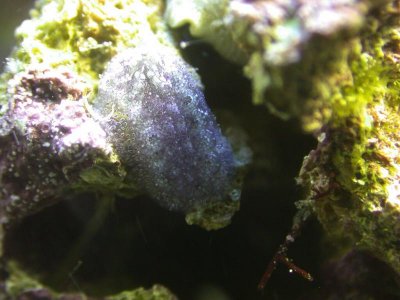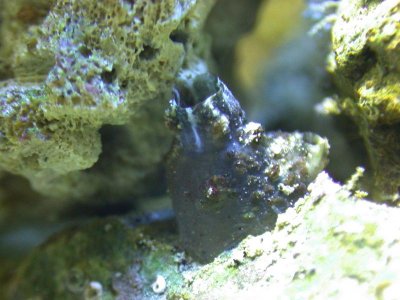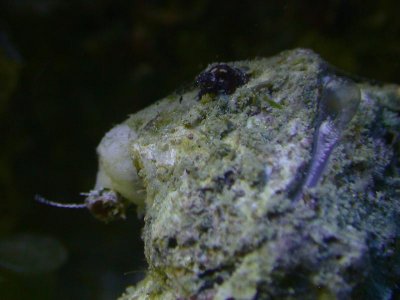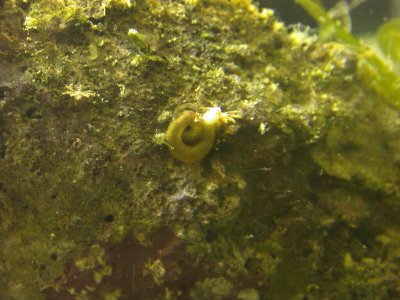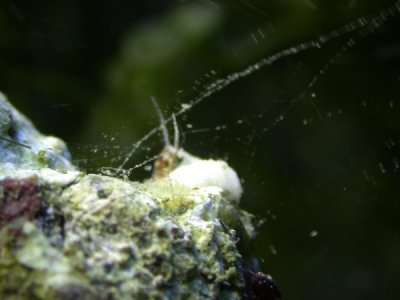You are using an out of date browser. It may not display this or other websites correctly.
You should upgrade or use an alternative browser.
You should upgrade or use an alternative browser.
Pix & ID: Critters that come in your rocks: the good and the bad.
- Thread starter Sk8r
- Start date
daplatapus
New member
Wow! I just found out what at least a half a dozen things are in my tank that I just couldn't get a pic of. Thanks!
And Sushigirl, your tank much be a veritable cornucopia of little critters
And Sushigirl, your tank much be a veritable cornucopia of little critters
evilvelle
In Memoriam
Man there are so many pests out there.Wish I could do it all over again with dry dead rock and QT everything. I would love to use the rock I have in my display on a bigger tank in the future but I know I have some unwanted hitchhikers is there a way to dip or clean the rocks of pests and still keep it live with all the beautiful coraline algae?
WetShepherd
New member
...is there a way to dip or clean the rocks of pests and still keep it live with all the beautiful coraline algae?
It's not the smartest thing I've ever done, but to get rid of the last few of my hitchhiking crabs (the ones so stubborn they wouldn't come out for even fresh water dips) I placed the pieces of LR that I suspected of having crabs into a bucket, then poured club soda through the holes/caves. The crabs got out in a big damn hurry.
It sounds extreme, but I suffered no discernible fallout for my ridiculous actions. I still have plenty of creepies and there was no increase in nitrates (i've never had ammonia). Before going crazy though, you could try an hour or two in a bucket without water with the lights off, or a short fresh water dip to see what you get.
All that being said, the time we spend with our live rock during the cycling process feels like a rite of passage. It's also a lot of fun. Maybe it gets old after you've set up several aquariums, but I think everyone in the hobby should go through those ups and downs at least once
**edit**
Here's the pic of my suspected eunicid - the pic isn't as good as sushi's (thanks so much for posting those!) but I think it's safe to call it a positive ID? Just above where the pics cuts off I have two colonies of Zoas :angryfire:

Last edited:
Looks like a eunicid to me. And thank you, Sushi Girl and Wet Shepherd, for those pictures! Good work!
Understand, there are very, very, very few of these things (the eunicid, the caulerpa algae, and the crabs) that are bad. The rest are all part of a healthy reef tank, and if you don't have them, then there are places to get them. There are dealers that will sell you these critters. Don't be too eager for coralline algae---especially if you have an acrylic tank. The stuff is pernicious. I spend more time scraping it off than I do green film algae.
This proliferation of small creepy-crawlies is why I prefer my live rock un-fussed-with. I don't want to kill off its diversity---a diversity which goes right down to the things you can't see, and which means that you've got a healthy community of things processing any waste or problem. Given really good water (check my sig line for params that work well) they'll keep themselves in balance. Copepods prey on pest algae. Other things prey on copepods. It's that circle of life thing. Cue music.
Understand, there are very, very, very few of these things (the eunicid, the caulerpa algae, and the crabs) that are bad. The rest are all part of a healthy reef tank, and if you don't have them, then there are places to get them. There are dealers that will sell you these critters. Don't be too eager for coralline algae---especially if you have an acrylic tank. The stuff is pernicious. I spend more time scraping it off than I do green film algae.
This proliferation of small creepy-crawlies is why I prefer my live rock un-fussed-with. I don't want to kill off its diversity---a diversity which goes right down to the things you can't see, and which means that you've got a healthy community of things processing any waste or problem. Given really good water (check my sig line for params that work well) they'll keep themselves in balance. Copepods prey on pest algae. Other things prey on copepods. It's that circle of life thing. Cue music.
The Gonk
New member
Copepods and amphipods---copepods are white dots that move. Amphipods look like rolypolys or sow bugs. They do not have visible eyes! [if you see on of those, it's bad!] Again, free fishfood, and you can't have dragonets with them.
...can't have dragonets without them, correct?
SK8R'S NOTE: thank you, Gonk! I've now fixed that. Silly me. It's a Friday, and I have no brain.
Last edited by a moderator:
Reef1121
New member
Is there such a thing as a "fire bristle worm"? I used to have a clam that was doing great till one day when I came home and its flesh was no longer attached to its shell and what looked like a bright red bristleworm came out of it. When I went to take it out it stung me. Ended up taking it out with some tweezers into a bag to my LFS where they told me it was a fire worm.
There's a lot of confusion about this. Fireworms (hermodice carunculata) are very, very rare in our hobby. They come from the Atlantic and around Ascension Island in the South Atlantic. Most of our stuff is from the Pacific. I have been at this for decades and I have never seen one except in pictures, even when I did have an Atlantic tank. So I'm a little skeptical of the fish store's id.
Fireworms have luxuriant huge pale tufts of bristles, and a conspicuously broad back compared to any other bristleworm.
They're not the only bad worm: oenone fulgida preys on clams.
And eunicids are the other large and troublesome sort of worm.
This is a link to a very amply illustrated RC article on Bad Worms. http://www.reefkeeping.com/issues/2003-04/rs/index.php
Understand this, however: if something died and you see a worm exit the shell or skeleton, generally thank it, don't kill it---because worms are encouraged in our tank to be undertakers.
Bristleworms, hermits, and nassarius snails always come to the scent of something starting to rot, and they will clean it up for you before it causes a tank crash. That's why you should never, ever, ever eliminate the bristleworm population from a tank. They're a little like surgeons, and can even help an ailing coral survive a water crisis, by eating off the dead tissue (proper bristleworms cannot possibly eat healthy tissue: they literally suck up the slime of decay, which is their food, and their mouths can only suck, not gnaw.) If I have a coral in trouble, I am glad to see bristleworms at work: they operate delicately, and sometimes the coral can then go on healing, now that the marine equivalent of gangrene has been sucked away to leave healthy flesh.
Nor do they sting, really: their bristles have little hooks, and the ridges on our fingers catch those and embed the little calcium carbonate bristles in our skin: hard on the poor worm, and hard on us. Vinegar will help dissolve those, and hot water on the site of the 'sting' will ease the discomfort. This is a good reason for us to wear gloves when moving rock. If a fish turns up with a face full of bristles, don't panic: they fall off after 3 days and the fish learns not to mess with bristleworms. I had a firefish take 3 tries at learning this---but he did learn.
Fireworms have luxuriant huge pale tufts of bristles, and a conspicuously broad back compared to any other bristleworm.
They're not the only bad worm: oenone fulgida preys on clams.
And eunicids are the other large and troublesome sort of worm.
This is a link to a very amply illustrated RC article on Bad Worms. http://www.reefkeeping.com/issues/2003-04/rs/index.php
Understand this, however: if something died and you see a worm exit the shell or skeleton, generally thank it, don't kill it---because worms are encouraged in our tank to be undertakers.
Bristleworms, hermits, and nassarius snails always come to the scent of something starting to rot, and they will clean it up for you before it causes a tank crash. That's why you should never, ever, ever eliminate the bristleworm population from a tank. They're a little like surgeons, and can even help an ailing coral survive a water crisis, by eating off the dead tissue (proper bristleworms cannot possibly eat healthy tissue: they literally suck up the slime of decay, which is their food, and their mouths can only suck, not gnaw.) If I have a coral in trouble, I am glad to see bristleworms at work: they operate delicately, and sometimes the coral can then go on healing, now that the marine equivalent of gangrene has been sucked away to leave healthy flesh.
Nor do they sting, really: their bristles have little hooks, and the ridges on our fingers catch those and embed the little calcium carbonate bristles in our skin: hard on the poor worm, and hard on us. Vinegar will help dissolve those, and hot water on the site of the 'sting' will ease the discomfort. This is a good reason for us to wear gloves when moving rock. If a fish turns up with a face full of bristles, don't panic: they fall off after 3 days and the fish learns not to mess with bristleworms. I had a firefish take 3 tries at learning this---but he did learn.
Reef1121
New member
The worm looked like this
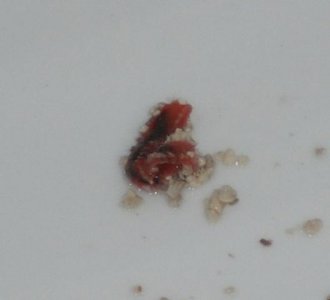
And thanks for all the great information. Ive been told for the past few years that Ive been in the hobby that worms are bad and to get rid of them as soon as possible or to buy all dry everything so that you can manage what goes in and out of your tank, but all this information was great. Ill stop taking these red guys out of the tank from now on when I see them.

And thanks for all the great information. Ive been told for the past few years that Ive been in the hobby that worms are bad and to get rid of them as soon as possible or to buy all dry everything so that you can manage what goes in and out of your tank, but all this information was great. Ill stop taking these red guys out of the tank from now on when I see them.
Lucky you! You've got Atlantic rock, I'm strongly suspecting. A regular program of fireworm removal is about all you can do. Usually I'm strongly against the keeping of arrow crabs, precisely because they'll eat every worm in your tank, but housing one of these little worm-eating-machines might be a good idea, to get the young ones while you remove the big ones, which will likely be too much for him: and I hope he will eat this species. Then you're going to have to get some nice Pacific bristleworms, which luckily can be had for not very much, or free. You might also try this: get a liter or half liter wine carafe or other narrownecked bottle. Put a nice piece of raw shimp in it just before lights out, and prop the neck up against the rocks, giving the bottle about a 45 degree tilt.
In the morning, with luck, you may find it has trapped some worms which won't have been able to get back up that slope.
There are also worm traps, for the very little guys: search our sponsors.
HTH.
In the morning, with luck, you may find it has trapped some worms which won't have been able to get back up that slope.
There are also worm traps, for the very little guys: search our sponsors.
HTH.
WetShepherd
New member
Thanks for the advice. They have arrow crabs up at my LFS but idk if they'll get along well with my cleaner and peppermint shrimp so I'll prob just stick to setting traps at night or investing in one of the manufactured worm traps they sell at the store.
And don't forget to keep pics of your captured monsters. In ten years time you'll be able to post them up with your war stories for new reefers
Reefing Newbie
New member
Sk8r, may I ask where you obtain bristleworms? I haven't seen any for sale and have a feeling that I may have lost quite a few during my tear down. Most were in the fuge but everything in the fuge was thrown out because a extremely bad odor. I tried boiling some of the coral skeletons(bristleworms love them) and a large conch shell(think from a full grown queen conch, bristly worms love this as well) and was unable to get the odor out of the skeletons. The shell doesn't have an odor any more and one brain coral skeleton is sentless now as well. Also, is there any place that would sell mini brittle stars?
kingfisher62
New member
I figured this would be an appropiate place to share these pics of one of my favorite hitch hikers on my rock.
Spaghetti worm


Spaghetti worm


SushiGirl
Premium Member
You have to watch the strombus snails, they're omnivores so they'll steal the mysis from your corals. I have to guard my little favia frag & my smaller candy cane coral after feeding, knocking off the snails. We went from 5 to at least 50 in a couple of months. We've given away about 25 so far. They graze the glass & rocks (any annoyingly the powerheads, which they get stuck in & rattle around), but when I feed they go for the meat.
Laying eggs

This one was reeling itself back up to the powerhead via an almost invisible string of mucus that it had lowered itself by. It changed its mind on the way down, I guess!

Laying eggs

This one was reeling itself back up to the powerhead via an almost invisible string of mucus that it had lowered itself by. It changed its mind on the way down, I guess!

Similar threads
- Replies
- 9
- Views
- 826

